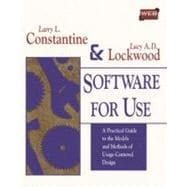
| Acknowledgments | xi | (2) | |||
| Preface | xiii | ||||
| SECTION I TOWARD MORE USABLE SOFTWARE | 1 | (66) | |||
|
3 | (18) | |||
|
3 | (9) | |||
|
12 | (6) | |||
|
18 | (3) | |||
|
21 | (20) | |||
|
21 | (2) | |||
|
23 | (2) | |||
|
25 | (8) | |||
|
33 | (8) | |||
|
41 | (26) | |||
|
41 | (4) | |||
|
45 | (1) | |||
|
46 | (5) | |||
|
51 | (12) | |||
|
63 | (2) | |||
|
65 | (2) | |||
| SECTION II ESSENTIAL MODELS FOR USABILITY | 67 | (80) | |||
|
69 | (28) | |||
|
69 | (1) | |||
|
70 | (8) | |||
|
78 | (6) | |||
|
84 | (2) | |||
|
86 | (3) | |||
|
89 | (8) | |||
|
97 | (28) | |||
|
97 | (2) | |||
|
99 | (10) | |||
|
109 | (6) | |||
|
115 | (4) | |||
|
119 | (6) | |||
|
125 | (22) | |||
|
125 | (2) | |||
|
127 | (8) | |||
|
135 | (6) | |||
|
141 | (6) | |||
| SECTION III CREATING THE VISUAL DESIGN | 147 | (62) | |||
|
149 | (16) | |||
|
149 | (1) | |||
|
150 | (8) | |||
|
158 | (7) | |||
|
165 | (20) | |||
|
165 | (1) | |||
|
166 | (4) | |||
|
170 | (9) | |||
|
179 | (6) | |||
|
185 | (24) | |||
|
185 | (4) | |||
|
189 | (5) | |||
|
194 | (11) | |||
|
205 | (4) | |||
| SECTION IV COMPLETING THE DESIGN | 209 | (180) | |||
|
211 | (20) | |||
|
211 | (1) | |||
|
212 | (6) | |||
|
218 | (7) | |||
|
225 | (6) | |||
|
231 | (34) | |||
|
231 | (1) | |||
|
232 | (5) | |||
|
237 | (6) | |||
|
243 | (5) | |||
|
248 | (5) | |||
|
253 | (12) | |||
|
265 | (32) | |||
|
265 | (2) | |||
|
267 | (1) | |||
|
268 | (4) | |||
|
272 | (8) | |||
|
280 | (13) | |||
|
293 | (4) | |||
|
297 | (20) | |||
|
297 | (1) | |||
|
298 | (1) | |||
|
299 | (1) | |||
|
300 | (8) | |||
|
308 | (5) | |||
|
313 | (4) | |||
|
317 | (40) | |||
|
317 | (1) | |||
|
317 | (13) | |||
|
330 | (8) | |||
|
338 | (16) | |||
|
354 | (3) | |||
|
357 | (32) | |||
|
357 | (1) | |||
|
358 | (1) | |||
|
359 | (7) | |||
|
366 | (12) | |||
|
378 | (11) | |||
| SECTION V ASSESSMENT AND IMPROVEMENT | 389 | (74) | |||
|
391 | (26) | |||
|
391 | (8) | |||
|
399 | (2) | |||
|
401 | (12) | |||
|
413 | (4) | |||
|
417 | (26) | |||
|
417 | (1) | |||
|
418 | (5) | |||
|
423 | (3) | |||
|
426 | (15) | |||
|
441 | (2) | |||
|
443 | (20) | |||
|
443 | (1) | |||
|
444 | (6) | |||
|
450 | (6) | |||
|
456 | (4) | |||
|
460 | (3) | |||
| SECTION VI ORGANIZING AND MANAGING THE PROCESS | 463 | (70) | |||
|
465 | (16) | |||
|
465 | (7) | |||
|
472 | (3) | |||
|
475 | (6) | |||
|
481 | (30) | |||
|
481 | (4) | |||
|
485 | (4) | |||
|
489 | (5) | |||
|
494 | (4) | |||
|
499 | (12) | |||
|
511 | (22) | |||
|
511 | (2) | |||
|
513 | (4) | |||
|
517 | (5) | |||
|
522 | (2) | |||
|
524 | (9) | |||
| Appendix A: Suggested Readings | 533 | (2) | |||
| Appendix B: Eleven Ways to Make Software More Usable: General Principles of Software Usability | 535 | (2) | |||
| Appendix C: Glossary | 537 | (8) | |||
| Appendix D: Forms for Usage-Centered Design | 545 | (4) | |||
| Appendix E: Subjective Usability Scales for Software (SUSS) | 549 | (2) | |||
| References | 551 | (10) | |||
| Index | 561 |
The New copy of this book will include any supplemental materials advertised. Please check the title of the book to determine if it should include any access cards, study guides, lab manuals, CDs, etc.
The Used, Rental and eBook copies of this book are not guaranteed to include any supplemental materials. Typically, only the book itself is included. This is true even if the title states it includes any access cards, study guides, lab manuals, CDs, etc.